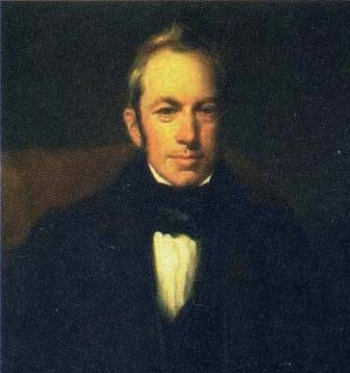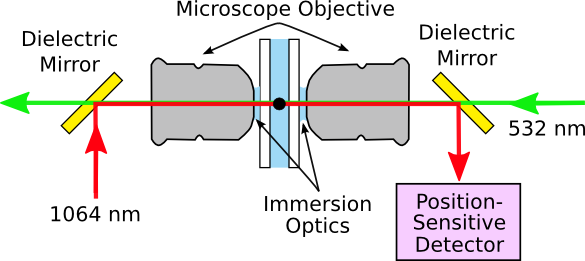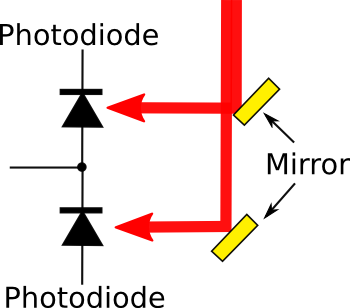Close Observation of Brownian Motion
April 28, 2014
Science often proceeds from
accidental observations, and such an observation occurred in 1827 when
Robert Brown, a
botanist, was observing
pollen grains under a
microscopic. His
sample contained not just pollen, but also
amyloplasts, small, subsidiary particles associated with pollen grains, and
spherosomes. Brown noticed that these were in a continual motion.
To exclude the idea that these motions arose from the
biological nature of the particles, Brown found that this motion also existed in
inorganic particles. This
random motion of particles in
fluids is now known as
Brownian motion. It's caused by the impact of fluid
molecules. Brownian motion is still an active
research topic after all these years.
ArXiv had 190 articles containing "Brownian" in their title in the years 2010-2013.

Scottish botanist, Robert Brown (1773-1858).
Brown, who also did research in paleobotany, was among the first to use a microscope in his studies. These included the differentiation of gymnosperms from angiosperms (flowering plants).
(Oil portrait by Henry William Pickersgill (1782-1875), via Wikimedia Commons.)
As I wrote in a
previous article (Maxwell, Boltzmann and Brown, September 14, 2011),
physicists from the
Center for Nonlinear Dynamics and Department of Physics of the
University of Texas at Austin (Austin, Texas) investigated the Brownian motion of individual
micrometer-sized particles of
silica glass beads in
air.[1-2] The particles were held in place by an
optical tweezer.
In those
experiments, the
temporal resolution of the measurement was fine enough to to observe the individual "hits" by the gas molecules, the so-called
ballistic regime.[1-2]
In further work with
colleagues at the
Ecole Polytechnique Fédérale de Lausanne, the Texas team extended their observations to Brownian motion in a
liquid with measurement of the motion of a particle to
sub-Angstrom spatial resolution. The
spatial resolution of these measurements was 20
picometers, which is about the size of a
hydrogen atom, and the temporal resolution was about 15
nanoseconds.[3]
Motions of Brownian particles will ideally obey the
Stokes-Einstein relation,

in which
D, the
diffusion constant, is related to the
Boltzmann constant,
kB, the
absolute temperature,
T, the
viscosity,
η, and the particle radius,
r. Plugging in the numbers shows that a one
micrometer silica bead in water will move a
nanometer every
microsecond.
The Texas team has been improving their technique with results published in a recent issue of
Science.[4] Their
apparatus, as shown in the figure, consists of
counterpropagating laser beams, one at 532 nm, and the other at 1064 nm. These are medium
power lasers of about 200
milliwatts, but they're
focused by
water-immersion microscope objectives so that the
power density incident at the liquid-suspended particles is large.

Simplified diagram of the University of Texas at Austin optical tweezer apparatus for measurement of a particle's Brownian motion in a fluid. (Illustration by the author using Inkscape.)
Particles are introduced into the tweezer area by a flow-cell, and the
horizontal motion of the optically-trapped particle is measured by a
position-sensitive detector. A simplified diagram of the detector is shown in the figure. The detector signals are
digitized and stored on a
computer for later
analysis.

It's all done with mirrors.
The essential elements of the position sensitive detector used in the Texas experiments are two mirrors and two photodiodes.
(Illustration by the author using Inkscape.)
The motivation of this research is explication of
hydrodynamic effects that occur at very short time scales. The present apparatus is able to achieve
shot-noise-limited position sensitivity below three
femtometers per
square-root-hertz in a
bandwidth of 50
MHz. Two types of particles were used in the recent experiments, lighter
silica, and heavier
barium titanate glass. Fluids were
water (1.00
cP at 20
°C) and the less
viscous acetone (0.33 cP at 20°C).
Analysis of two million velocity readings showed that the particle velocity agreed with the
Maxwell-Boltzmann distribution within the experimental uncertainty. The root-mean-squared velocity of the barium titanate particles in acetone was 0.180
mm/s at 291
K. One indicator of interesting hydrodynamics was a small
correlation between the particle velocity and
thermal forces experienced at a future time.
Causality, however, is intact, since the future forces are correlated with past forces.
As are so many things in
Texas, this research was funded by the
Sid W. Richardson Foundation and the
Robert A. Welch Foundation.
References:
- Tongcang Li, Simon Kheifets, David Medellin and Mark G. Raizen, "Measurement of the Instantaneous Velocity of a Brownian Particle," Science, vol. 328 no. 5986 (June 25, 2010), pp. 1673-1675.
- Peter N. Pusey, "Brownian Motion Goes Ballistic," Science, vol. 332 no. 6031 (May 13, 2011), pp. 802-803.
- Rongxin Huang, Isaac Chavez, Katja M. Taute, Branimir Lukić, Sylvia Jeney, Mark G. Raizen and Ernst-Ludwig Florin, "Direct observation of the full transition from ballistic to diffusive Brownian motion in a liquid," Nature Physics, vol. 7, no. 7 (July, 2011), pp. 576-580.
- Simon Kheifets, Akarsh Simha, Kevin Melin, Tongcang Li, and Mark G. Raizen, "Observation of Brownian Motion in Liquids at Short Times: Instantaneous Velocity and Memory Loss," Science, vol. 343, no. 6178 (March 28, 2014), pp. 1493-1496.
- Web Site of the Raizen Group at the University of Texas at Austin.
Permanent Link to this article
Linked Keywords: Serendipity; accidental observation; botany; botanist; pollen grain; microscope; microscopic; sample; amyloplast; spherosome; biology; biological; inorganic compound; randomness; random; fluid; Brownian motion; molecule; research; ArXiv; Scotland; Scottish; Robert Brown (1773-1858); paleobotany; gymnosperm; angiosperm; Henry William Pickersgill (1782-1875); Wikimedia Commons; physicist; Center for Nonlinear Dynamics and Department of Physics; University of Texas at Austin (Austin, Texas); micrometer; silica glass bead; atmosphere of Earth; air; optical tweezer; experiment; temporal resolution; ballistic; colleague; Ecole Polytechnique Fédérale de Lausanne; liquid; Angstrom; spatial resolution; picometer; hydrogen atom; nanosecond; Stokes-Einstein relation; diffusion constant; Boltzmann constant; thermodynamic temperature; absolute temperature; viscosity; silicon dioxide; silica; nanometer; microsecond; Science; laboratory equipment; apparatus; wave propagation; counterpropagating; laser beam; power; milliwatt; focus; water-immersion microscope objective; power density; Inkscape; horizontal motion; position-sensitive detector; digitizing; digitized; computer; data analysis">analysis; mirror; photodiode; hydrodynamic; shot noise; shot-noise-limited; femtometer; square-root-hertz; bandwidth; hertz; MHz; silicon dioxide; silica; barium titanate; glass; water; Poise; cP; Celsius; viscosity; viscous; acetone; Maxwell-Boltzmann distribution; meter per second; mm/s; kelvin; K; correlation; thermal energy; thermal force; causality; Texas; Sid W. Richardson Foundation; Robert A. Welch Foundation.